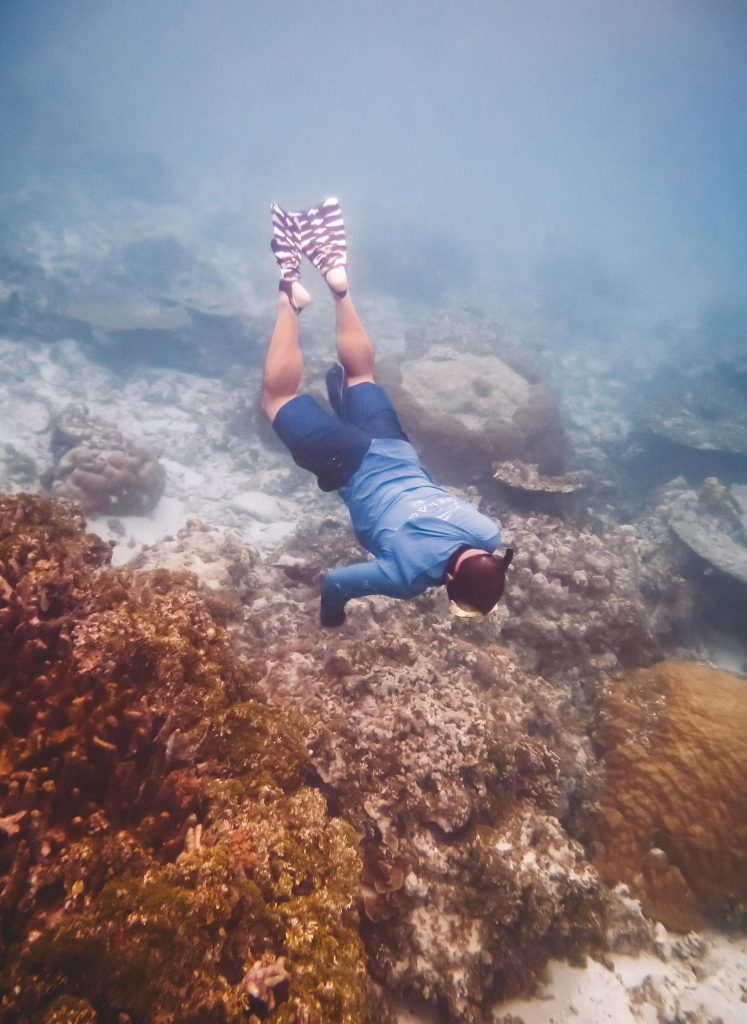For the first time, nuisance Chondria tumulosa red alga detected beyond Papahānaumokuākea

A red alga first found by University of Hawaiʻi at Mānoa researchers smothering coral reefs in Papahānaumokuākea Marine National Monument (PMNM) has been detected for the first time by the team outside of the marine monument and more than 2,000 miles away.
The research team detected DNA matching Chondria tumulosa in Majuro Atoll in the Republic of the Marshall Islands in the east-central Pacific Ocean. Papahānaumokuākea is a chain of islands and atolls that extends approximately 1,200 miles northwest of the main Hawaiian Islands in the northern Pacific.
“Our discovery in Majuro suggests that C. tumulosa may be more widespread than we previously thought. This could have significant implications for coral reef ecosystems across the Pacific, potentially requiring broader monitoring efforts and a more comprehensive understanding of the alga’s distribution and ecological impact,” said UH Mānoa School of Life Sciences graduate student Patrick Nichols.
First detected in 2016 and named in 2020 by UH researchers, C. tumulosa has earned a reputation for smothering coral reefs in PMNM, where it forms dense mats that blanket corals and other native organisms. Its mat-forming behavior, ability to spread rapidly, and unknown origin have posed significant challenges for reef conservation.
Until now, the alga had only been observed spreading throughout the three northwestern-most atolls of PMNM: first at Manawai (Pearl and Hermes), then Kuaihelani (Midway Atoll) and Hōlanikū (Kure Atoll). However, a new detection outside of Hawaiʻi caught the researchers by surprise.
The discovery was made possible by the detection of the species’ DNA from water samples obtained earlier this year, emphasizing the pivotal role of environmental DNA (eDNA) as a front-line tool in the early detection of harmful nuisance species.
The discovery in Majuro was a two-step process that combined molecular surveillance with targeted fieldwork to detect a species that is otherwise extremely difficult to visually identify. The process began with the eDNA analysis, a bio-monitoring technique that screens water samples for the nuisance alga’s genetic “fingerprint.”
The genetic test for C. tumulosa eDNA was developed by UH researchers in partnership with the US Fish and Wildlife Service and the National Oceanic and Atmospheric Administration, and can detect the presence of target species across vast areas without the need for extensive in-water surveys.
Armed with this evidence, UH graduate students Patrick Nichols (School of Life Sciences), Keolohilani Lopes Jr. (Department of Natural Resources and Environmental Management) and Jimmy Fumo (School of Life Sciences) traveled to Majuro in November 2024 to conduct an extensive survey, including the site of the initial positive eDNA detection. Using microscopy and additional genetic sampling, they were able to visually confirm the presence of C. tumulosa.
At Manawai in PMNM, C. tumulosa has been observed forming thick mats that suffocate coral reef communities, displacing native flora and fauna. In Majuro, however, the species was observed in much lower abundance, forming small patches at some sites. This growth pattern resembles what was discovered in 2023 at Hōlanikū (Kure Atoll) in PMNM where C. tumulosa grew cryptically and was difficult to identify.
“Even though we have now observed C. tumulosa outside of PMNM we can’t be sure of its native status,” Fumo said. “Its relatively low abundance in Majuro could mean it is either an emerging invader in the region or a long-established species being naturally controlled by herbivorous reef fishes or other ecological factors.”
With other potential sightings throughout the region, researchers plan to extend their surveys beyond the Marshall Islands to better understand the alga’s distribution and ecological role. They hope to explore the historical connections between populations in Hawaiʻi and elsewhere to determine if the species has recently spread across the north Pacific or has been established in the region for a longer period of time.
The team’s work in Majuro builds on years of collaboration between UH Mānoa researchers and local stakeholders throughout the Hawaiian archipelago.
“While this discovery raises concerns about the spread of C. tumulosa, it also showcases the incredible potential of new technologies and collaboration,” Nichols said. “By working together on new tools, we can better understand and mitigate the risks posed by nuisance species.”



















